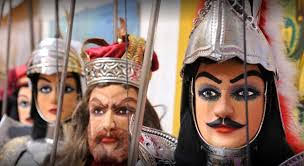
I PUPI SICILIANI—Parte I
Mentre facevo delle ricerche sul tema di marionette, burattini e pupi ho
trovato, sul sito del Comune di Catania, un articolo interessante
intitolato Storia dei Pupi Siciliani scritto dal Prof. Alessandro Napoli. Ve
lo offro in varie fasi: per prima, l’introduzione generale, poi informazioni
sulla tradizione palermitana e in fine la tradizione catanese.
[https://www.comune.catania.it/la-citta/tradizioni/pupisiciliani]
L’Opera dei Pupi è un particolare tipo di teatro delle marionette che si
affermò stabilmente nell’Italia meridionale e soprattutto in Sicilia tra la
seconda metà dell’Ottocento e la prima metà del Novecento.
I pupi siciliani si distinguono dalle altre marionette essenzialmente per
la loro peculiare meccanica di manovra e per il repertorio, costituito
quasi per intero da narrazioni cavalleresche derivate in gran parte da
romanzi e poemi del ciclo carolingio.
Le marionette del Settecento venivano animate dall’alto per mezzo di
una sottile asta metallica collegata alla testa attraverso uno snodo e
per mezzo di più fili, che consentivano i movimenti delle braccia e delle
gambe. In Sicilia, nella prima metà dell’Ottocento, un geniale artefice
di cui ignoriamo il nome escogitò gli efficaci accorgimenti tecnici che
trasformarono le marionette in pupi.
Egli fece in modo che l’asta di metallo per il movimento della testa non
fosse più collegata ad essa tramite uno snodo, ma la attraversasse
dall’interno e - cosa ben più importante - sostituì il sottile filo per
l’animazione del braccio destro con la robusta asta di metallo,
caratteristica del pupo siciliano. Questi nuovi espedienti tecnici
consentirono di imprimere alle figure animate movimenti più rapidi,
diretti e decisi, e perciò particolarmente efficaci per “imitare” sulla
scena duelli e combattimenti, che tanta parte avevano nelle storie
cavalleresche.
Esistono in Sicilia due differenti tradizioni, o “stili”, dell’Opera dei Pupi:
quella palermitana, affermatasi nella capitale e diffusa nella parte
occidentale dell’isola, e quella catanese, affermatasi nella città etnea
e diffusa, a grandi linee, nella parte orientale dell’isola ed anche in
Calabria. Le cronache raccontano che l’iniziatore dell’Opera a Catania fu
don Gaetano Crimi (1807 - 1877), il quale aprì il suo primo teatro nel
1835.
Le due tradizioni differiscono per dimensioni e peso dei pupi, per alcuni
aspetti della
meccanica e del sistema di manovra, ma soprattutto per una diversa
concezione teatrale e dello spettacolo, che ha fatto sì che nel catanese
si affermasse un repertorio cavalleresco ben più ampio di quello
palermitano e per molti aspetti diverso.
While I was researching the topic of marionettes and puppets, I found,
on the website of the City of Catania (Sicily), an interesting article
entitled The History of the Sicilian Puppets written by Professor
Alessandro Napoli. I will share it with you in various phases: firstly, a
general introduction, then information on the tradition in the city of
Palermo and finally the tradition in the city of Catania.
[https://www.comune.catania.it/la-citta/tradizioni/pupisiciliani]
The “Pupi Opera” is a specific type of marionette theatre that
formalized in Southern Italy, and mostly in Sicily between the second
half of the 1800’s and the first half of the 1900’s. Sicilian Pupi, set
themselves apart from other marionettes essentially for their specific
way of movement and for the repertoire, which is composed almost in
its entirety of stories of knights is derived mostly from tales and poems
of the Carolingian Cycle.
The marionettes from the 1700’s were animated from above via a thin
metal wand tied to the head by means of a junction or intersection and
many strings, which allowed movement of the arms and legs. In Sicily,
during the first half of the 1800’s, a brilliant artisan, whose name we do
not know, devised the useful techniques that transformed the
marionettes into Pupi.
He enabled the metal wand that controlled the movements of the head
to no longer be connected by a junction, rather traversing it from the
inside and—a far more important thing—substituting the thin thread
that animated the right arm with the strong metal wand, characteristic
of the Sicilian Pupo. These new technical devices gave the animated
figures movements that were more rapid, direct and decisive, and,
therefore, particularly efficacious to “imitate” on the stage the duels
and fights, which had comprised so many of the chivalric tales.
In Sicily there are two different traditions or “styles” of the Theatre of
the Pupi: the one from Palermo established in the capitol and spread
throughout the western part of the island, and the one from Catania,
established in the city near Mount Etna and spread, for the most part in
the eastern part of the island and even in Calabria. Stories are told
that the founder of the Theatre in Catania was Don Gaetano Crimi
(1807-1877) who opened his first theatre in 1935.
The two traditions differ in the size and weight of the pupi, according
to certain aspects of their mechanics and their system of movement,
but most of all due to a different theatrical conception of the show or
spectacle, that enabled the Catania theatre to establish a knightly
repertoire which is much broader than the one from Palermo and in
many ways, different from it.
Saturday, January 11, 2025